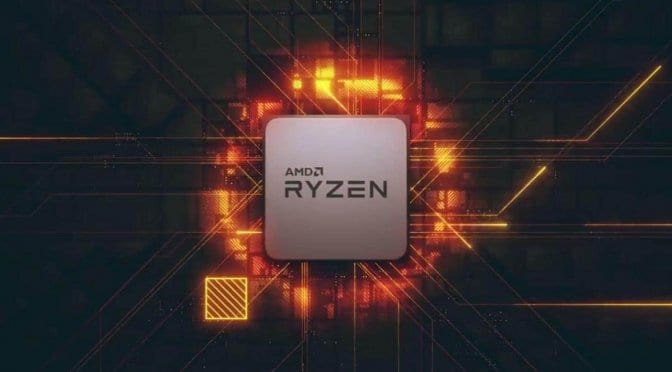As you know AMD recently announced its Ryzen 5000-series Zen 3-based Vermeer desktop CPU lineup. According to AMD these CPUs will offer better single-thread performance in PC games. AMD also lifted the review embargo and first third-party gaming benchmarks were also published.
AMD’s Zen 3 architecture promises to offer a higher boost clock, significant IPC uplift, new core layout, and a new cache topology. In fact, AMD also claims that Zen 3 offers a 19% increase in single-thread scenarios over the previous-gen CPU lineup. AMD released four SKUs based on Zen 3 arch, the Ryzen 5 5600X, Ryzen 7 5800X, Ryzen 9 5900X and the Ryzen 9 5950X, respectively.
Now someone has decided to delid this new ZEN 3-based CPU, and has posted some high-resolution infrared photos of the processor/die. One Hardwareluxx community member grabbed a Ryzen 5 5600X, delidded it and tried to take a look under the processor’s hood.
The Die shot has been posted by Fritzchens Fritz, and more pictures can be found in this Flickr photo stream album. Fritzchens has posted many CPU/GPU die shots in the past as well.
https://t.co/uEF14XgsB6 pic.twitter.com/KKkHd7UXKt
— Fritzchens Fritz (@FritzchensFritz) November 8, 2020
You’ll immediately notice the damage done when the user de-lidded the processor, but there are other pictures revealing some details of the die shot. The CPU in particular is the AMD Ryzen 5 5600X. From the photos we can clearly see both the I/O Die (IOD) and the Core Compute Die (CCD) that houses the eight Zen 3 cores on the Ryzen 5 5600X, but two of them are disabled to make a six-core chip.
The processor features two chiplets, a single CCD, and a primary IOD. The CPU had to be delidded by removing the IHS to get a clear picture of the die. Ryzen 5000 CPUs basically make use of a ‘solder design’ so it was not easy to delid this processor, since the whole CCD ripped off during the process as evident from the photos.
We can see mounting pads next to the CCD, reserved for a second CCD, which would be used to install a Ryzen 9 chip. In the close-up die shots, you can see some of the CPU cores and the L3 cache in the middle of the CCD as well. One Twitter user @Locuza has mapped the rest of the Ryzen 5000 die, the entire Zen 3 CCD, with each area of the chip being accurately mapped.
Awesome work by Fritzchens again!
FPU and uCode position appears to be the same.
L1D$ looks very similar.
uOP$, L1I$, BTBs were moved a bit and look quite different.
L2$ appears nearly identical.
L3$ design has multiple changes.
A Zen3 core is quite a bit longer than a Z2 Core https://t.co/NVC1I9XlUW pic.twitter.com/G6TlsjQ2eg— Locuza (@Locuza_) November 8, 2020
He highlighted some important points:
- FPU and uCode position appears to be the same.
- L1D$ looks very similar.
- uOP$, L1I$, BTBs was moved a bit and look quite different.
- L2$ appears nearly identical.
- L3$ design has multiple changes.
- Zen3 core is quite a bit longer than a Z2 Core
In previous gen Ryzen CPU design each CCD comprised of two CCX’s (Core Complexes). Zen 3 CCD on the other hand consists of a single CCX featuring 8 cores that can run in either a single-thread mode (1T) or a two-thread mode (2T), up to 16 threads in total per CCX.
Both the 3rd and 4th-gen AMD Ryzen architectures work on a multi-die based system. The cores and cache are housed in their own dies called CCDs. The memory, I/O, and all communication between CCDs done via the AMD Infinity Fabric is handled by the I/O Die. So AMD can basically use different nodes for different dies to manufacture CPUs.
The bigger I/O die uses TSMC’s 12nm process, while the CCDs use the 7nm node, again from TSMC. AMD Zen 3 CCX consists of 512KB of L2 per core for a total of 4MB L2 cache per CCD, and up to 32MB of L3 cache shared across all the cores.
Moreover, AMD Zen 3 CCD measures at 83.736mm2. For comparison, the Zen 2 CCD was around 72mm2. This means Zen 3 CCD is almost 16% larger in size. The 12nm IOD (I/O Die) measures at 124.29mm2, same as previous gen Ryzen 3000-series CPU lineup. The I/O die appears to be the biggest chip on the interposer.
Stay tuned for more!
Hello, my name is NICK Richardson. I’m an avid PC and tech fan since the good old days of RIVA TNT2, and 3DFX interactive “Voodoo” gaming cards. I love playing mostly First-person shooters, and I’m a die-hard fan of this FPS genre, since the good ‘old Doom and Wolfenstein days.
MUSIC has always been my passion/roots, but I started gaming “casually” when I was young on Nvidia’s GeForce3 series of cards. I’m by no means an avid or a hardcore gamer though, but I just love stuff related to the PC, Games, and technology in general. I’ve been involved with many indie Metal bands worldwide, and have helped them promote their albums in record labels. I’m a very broad-minded down to earth guy. MUSIC is my inner expression, and soul.
Contact: Email

